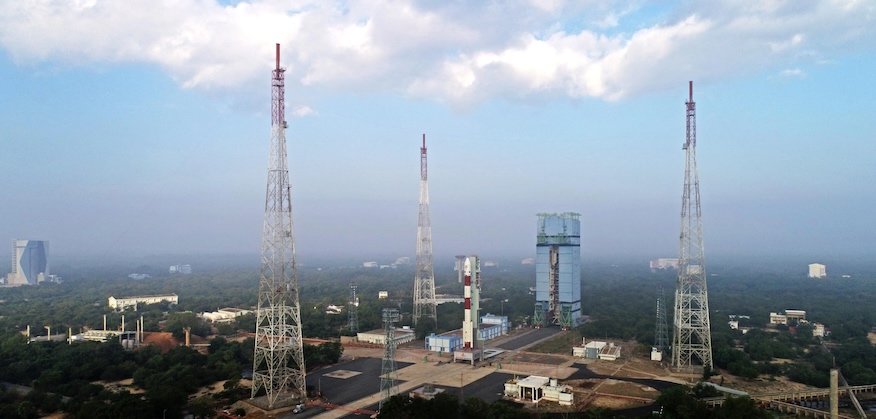The orbital launch calendar is set to begin just hours into the first day of 2024 based on Coordinated Universal Time (UTC). At 0340 UTC (9:10 a. m.
IST or 10:40 p. m. EST on Dec.
31), a rocket will liftoff from India to begin what will likely be another record-breaking global launch year. A four-stage Polar Satellite Launch Vehicle with two solid rocket boosters, abbreviated to PSLV-DL, will launch with two spacecraft onboard: the X-ray Polarimeter Satellite (XPoSat) and the PSLV Orbital Experimental Module-3 (POEM-3). The mission has the designation of PSLV-C58.
This New Year’s Day flight will be the 60th launch of a PSLV rocket and the fourth of the PSLV-DL variant. The mission marks India’s first foray into X-ray astronomy. The Indian Space Research Organization (ISRO) describes XPoSat as “the first dedicated scientific satellites from ISRO to carry out research in space-based polarization measurements of X-ray emission from celestial sources.
” The agency said the aim of the orbital observatory is to learn more about the degree and angle of polarization in hopes of better understanding the emissions from things, like neutron stars, pulsar wind nebulae, black holes and more. The mission is designed to last at least five years during which it will study about 50 so-called cosmic sources through the principal of particle acceleration called Thomson Scattering . To gather this data, XPoSat uses two primary instruments: POLIX, the X-ray Polarimeter that makes observations in the 8-30 keV energy band, and XSPECT (X-ray SPECtroscopy and Timing), a tool designed to “provide long-term monitoring of spectral state changes in continuum emission, changes in their line flux and profile, simultaneous long term temporal monitoring of soft X-ray emission in the X-ray energy range 0.
8-15 keV. ” The XPoSat is built upon the Indian Mini Satellite-2 (IMS-2) bus, a 400 kg spacecraft that can house payloads up to about 200 kg. Also hitching a ride on this mission is the POEM-3, which remains attached to the PS4, the uppermost stage of the PSLV-DL rocket.
There will be two burns of the PS4’s twin engines, which burn a combination of monomethylhydrazine (MMH) and mixed oxides of nitrogen (MON), to place the stage in a 350 km circular orbit. The POEM-3 hosts 10 payloads from ISRO and the Indian National Space Promotion and Authorization Center (IN-SPACe): This mission picks up after India closed out a historically successful year for its space program. 2023 marked a period where India became just the fourth nation in the world to achieve a soft landing on the surface of the Moon.
ISRO also launched the Aditya-L1 solar observatory as well as tested the Crew Escape System ahed of its first astronaut mission, dubbed Gaganyaan, which is expected to launch in either 2024 or 2025. The first launch in 2024 begins a month full of orbital launch activity, including new partnerships, a mission to the Moon and the long-awaited debut of a new rocket. In the opening week of the new year, SpaceX aims to launch two Falcon 9 rockets.
The first will include the first six Starlink satellites featuring direct-to-cell capabilities and the second sending Ovzon’s first satellite to geostationary orbit. A China-based commercial launch company, ExPace, is set to launch its solid-fuel Kuaizhou rocket on January 5, 2024, with an unknown payload. The following week, United Launch Alliance (ULA) is set to debut its Vulcan rocket, the successor to two of the company’s rockets: the Atlas 5 and the Delta 4 Heavy rockets.
The maiden flight will send Astrobotic’s Peregrine lunar lander on its way to the Moon. A January launch will set up the spacecraft to attempt a soft landing on Feb. 23.
No earlier than Jan. 17, Axiom Space will once again partner with SpaceX and its Falcon 9 rocket to send a four-member crew of private astronauts for a multi-day mission to the International Space Station. The quartet, commanded by former NASA astronaut Michael López-Alegría, will fly to the orbiting outpost aboard the Crew Dragon Freedom.
To round out the month, as a consequence of the ongoing Russian war in Ukraine, Northrop Grumman will launch its Cygnus cargo spacecraft onboard a SpaceX Falcon 9 rocket for the first time. The spacecraft, named the S. S.
Patricia “Patty” Hilliard Robertson, is set to launch from Space Launch Complex 40 (SLC-40) on Jan. 29. .
From: spaceflightnow
URL: https://spaceflightnow.com/2023/12/31/india-set-to-kick-off-2024-orbital-launch-year-with-x-ray-observatory-mission/



